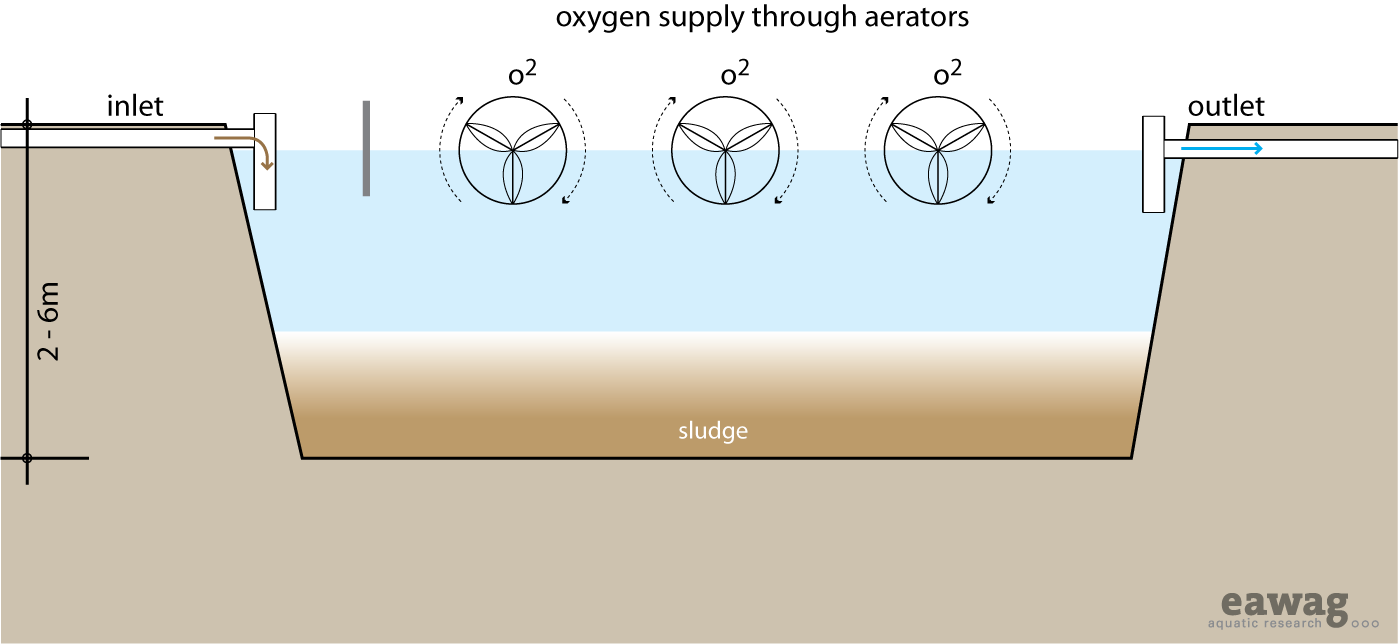Aerated Pond
|
|
|||||||||||||||||||||||||||
An aerated pond is a large, mixed, aerobic reactor. Mechanical aerators provide oxygen and keep the aerobic organisms suspended and mixed with water to achieve a high rate of organic degradation.
Increased mixing and aeration from the mechanical units means that the ponds can be deeper and tolerate much higher organic loads than a maturation pond. The increased aeration allows for increased degradation and increased pathogen removal. As well, because oxygen is introduced by the mechanical units and not by light-driven photosynthesis, the ponds can function in more northern climates.
Contents
Design Considerations
Influent should be screened and pre-treated to remove garbage and coarse particles that could interfere with the aerators. Because the aeration units mix the pond, a subsequent settling tank is required to separate the effluent from the solids.
The pond should be built to a depth of 2 to 5 m and should have a detention time of 3 to 20 days, depending on the treatment target. To prevent leaching, the pond should have a liner. This can be made from clay, asphalt, compacted earth, or any other impervious material. A protective berm should be built around the pond, using the fill that is excavated, to protect it from runoff and erosion.
| Advantages | Disadvantages/limitations |
|---|---|
| - Resistant to organic and hydraulic shock loads - High reduction of BOD and pathogens |
- Requires a large land area - High energy consumption, a constant source of electricity is required |
Appropriateness
A mechanically aerated pond can efficiently handle concentrated influent and significantly reduce pathogen levels. It is especially important that electricity service is uninterrupted and that replacement parts are available to prevent extended downtimes that may cause the pond to turn anaerobic.
Aerated ponds can be used in both rural and peri-urban environments. They are most appropriate for regions with large areas of inexpensive land located away from homes and businesses. Aerated lagoons can function in a larger range of climates than Waste Stabilization Ponds (T.5) and the area requirement is smaller compared to a maturation pond.
Health Aspects/Acceptance
The pond is a large expanse of pathogenic wastewater; care must be taken to ensure that no one comes in contact with or goes into the water.
References
- Arthur, J. P. (1983). Notes on the Design and Operation of Waste Stabilization Ponds in Warm Climates of Developing Countries. World Bank Technical Paper No. 7. The World Bank, Washington, D.C., US.
- Crites, R. and Tchobanoglous, G. (1998). Small and Decentralized Wastewater Management Systems. WCB/McGraw- Hill, New York, US. pp. 527-558. (Book; Comprehensive summary chapter)
- Tchobanoglous, G., Burton, F. L. and Stensel, H. D. (2004). Wastewater Engineering: Treatment and Reuse, Metcalf & Eddy, 4th Ed. (Internat. Ed.). McGraw-Hill, New York, US. pp. 840-854. (Book; Detailed design and example problems)
Acknowledgements
The material on this page was adapted from:
Elizabeth Tilley, Lukas Ulrich, Christoph Lüthi, Philippe Reymond and Christian Zurbrügg (2014). Compendium of Sanitation Systems and Technologies, published by Sandec, the Department of Water and Sanitation in Developing Countries of Eawag, the Swiss Federal Institute of Aquatic Science and Technology, Dübendorf, Switzerland.
The 2nd edition publication is available in English. French and Spanish are yet to come.

